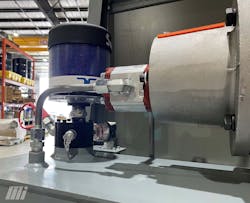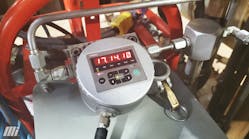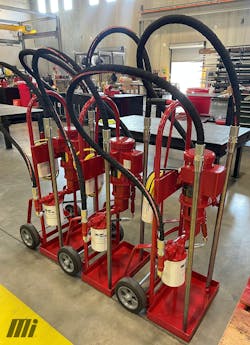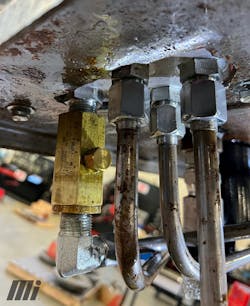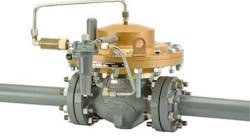Understanding filtration can be overwhelming and confusing. There are many different filter types to consider for a hydraulic system to have longevity, as hydraulic oil is the system’s lifeblood and should be treated as such. Like kidneys, filters remove contaminants such as particulates and water from hydraulic systems. This article will discuss multiple filter options, minimum requirements and best practices for filtration.
Filtration basics
Filter system basics start with suction strainers inside the tanks and a return line filter. Return line filters could be spin-on filters or tank-mounted. These units clean the fluid circulated by removing contaminants before being reintroduced into the system. At an entry-level, these filters are the minimum requirements for a hydraulic system. Suction filters are typically around 125 micron and return line filters could be between 25 to 10 micron as it returns to the reservoir. Both do a good job keeping large contaminants out of the pressure side.
Why high-pressure filters?
Beyond the minimum requirements, additional filtration could be leveraged for extra cleaning, such as high-pressure filters on the discharge side of the pump — which is high pressure, typically around 10 micron. Examples would be any operational valves, cylinders or manifolds. Should a pump fail, these high-pressure filters would prevent contamination from damaging those components. This is critical in any hydraulic system. These filters prevent a tremendous amount of downtime and component cost to a facility. Be sure to involve your in-house or qualified third-party fluid power specialist; they can assist in selecting the appropriate filter housing and filter element that best fits your application.
So many options
Each unit noted in this article has multiple options, which can cause confusion. Options include pressure drop across the filter, clogging indicators, micron rating, type of hydraulic oil, proportional or servo valves, and filter pressure ratings, to name a few. Each has a place in the hydraulic industry. Clean oil is required for all hydraulic systems. A trusted resource should be leveraged to assist in filter specification and placement.
Understanding component requirements
Knowledge is key to the factors of a filter element and how to protect a hydraulic system. Micron rating, for instance, refers to the particle size allowed to pass through the filter media; this is determined by the components in the system. Servo and proportional components generally require 3-micron filters in the system, whereas a manual spool valve may require a 10-micron filter. Identify your system’s components and find the smallest micron requirement on them; this should be the filter used in the system. You may have a 10-micron rating on some parts and 5-micron rating on others; the system should be designed with the lowest micron ratings. Each filter should also have a visual indicator that informs the maintenance person when the filter needs to be changed. The filter indicator options range from simple visual (red or green) pop-up style to gauge style and electronic, which has a remote indicator for monitoring at a control panel.
Some points in a hydraulic system must be noted when sizing filters. Two major components are a filter’s beta ratio and micron rating, which go hand in hand when sizing for the desired flow. Beta ratio can be defined as the number of particles of a minimum size in a system upstream compared to those of a larger size downstream. The higher the beta ratio, the higher the capture rate. The micron rating refers to the size of the particle the filter captures: the smaller the number, the smaller the particle the filter captures. Considering these factors when sizing the appropriate filter is extremely important so that system flow is not restricted. As much as contaminants should be kept out, not having enough flow would starve the system. Therefore, there is a fine balance in selecting the micron size and beta rating. A qualified fluid power professional can help you select the appropriate unit for your application.
Addressing dirty oil in brand-new drums or pails
The new oil you receive in the 55-gallon drums and 5-gallon pails is filthy — typically eight times too dirty. Most of this new oil has an ISO 23/21/18 contamination code, which means it contains between 40,000 to 80,000 4-micron particles per mL of oil, 10,000 to 20,000 6-micron particles per mL of oil and 1,300 to 2,500 14-micron particles per mL of oil. Note that an increase in ISO count by one doubles the amount of contamination in the system, while a decrease in ISO by one halves the contamination amount.
On-site filter carts are one of the most highly recommended investments you can make for your hydraulic systems. They are available in many configurations, including multistage micron elements 10/5/1 and water removal. There are two types of filtration methods: periodic and continuous filtration. Periodic filtration refers to cleaning oil on demand, while continuous filtration, also called kidney loop, refers to constantly cycling the hydraulic oil. These could occur while the machine is running or offline. When considering each option, always keep the flow rate of the filtration device in mind to ensure the system is not starved. Both maintain cleanliness levels and promote system longevity.
Reservoir maintenance
Hydraulic reservoir maintenance is often overlooked; this is where most contamination starts. Often, the culprit leaves the filler/breather cap off when adding oil to the system. Not only trash but a significant amount of moisture enters at this point, which causes rust in the reservoir and eventually makes its way through the hydraulic system.
Desiccant breathers remove moisture from the unit by trapping it before it enters the reservoir. Believe it or not, reservoirs breathe, and the components of a hydraulic system create heat—thus, a heating and cooling cycle with the oil. This heating and cooling can cause condensation and oil degradation as water enters and exits the oil. Additionally, ambient temperatures are vital to countering condensation, as it directly influences how much condensation may appear due to relative humidity factors.
Final thoughts
Hydraulic filtration is a vital component when it comes to dependability and maintenance. Knowing the options to increase a hydraulic system’s life is critical in today’s manufacturing processes — as critical as just-in-time production materials, supply chain solutions and qualified personnel. Today, many options exist to add remote monitoring technology, such as connected desiccant breathers, pressure sensors, flow sensors, pressure drop across filter elements, etc. All lead to better maintenance practices and regularly planned downtime for deeper service of your equipment.
Preventing catastrophic machine failure, maximizing runtime and reducing overall maintenance are the benefits of maintaining a clean hydraulic system. If you have any questions about the filtration at your facility, contact a fluid power specialist — you and your maintenance team will be glad you did.
Toby Potter started in the fluid power world in 1990 when he joined the US Navy, where his first assignment was the controllable pitch propeller system onboard USS Racine LST 1191. Upon leaving the Navy in 1994, he joined Motion Industries, where he was introduced to industrial fluid power and has not looked back. Potter is passionate about his work and keen to help customers solve problems. He left Motion in 2001 and worked around the country with various fluid power industries before returning to Motion. After being promoted to Fluid Power Specialist in 2020, he has enjoyed learning new things from his team and being innovative daily in the fluid power world.
Motion
